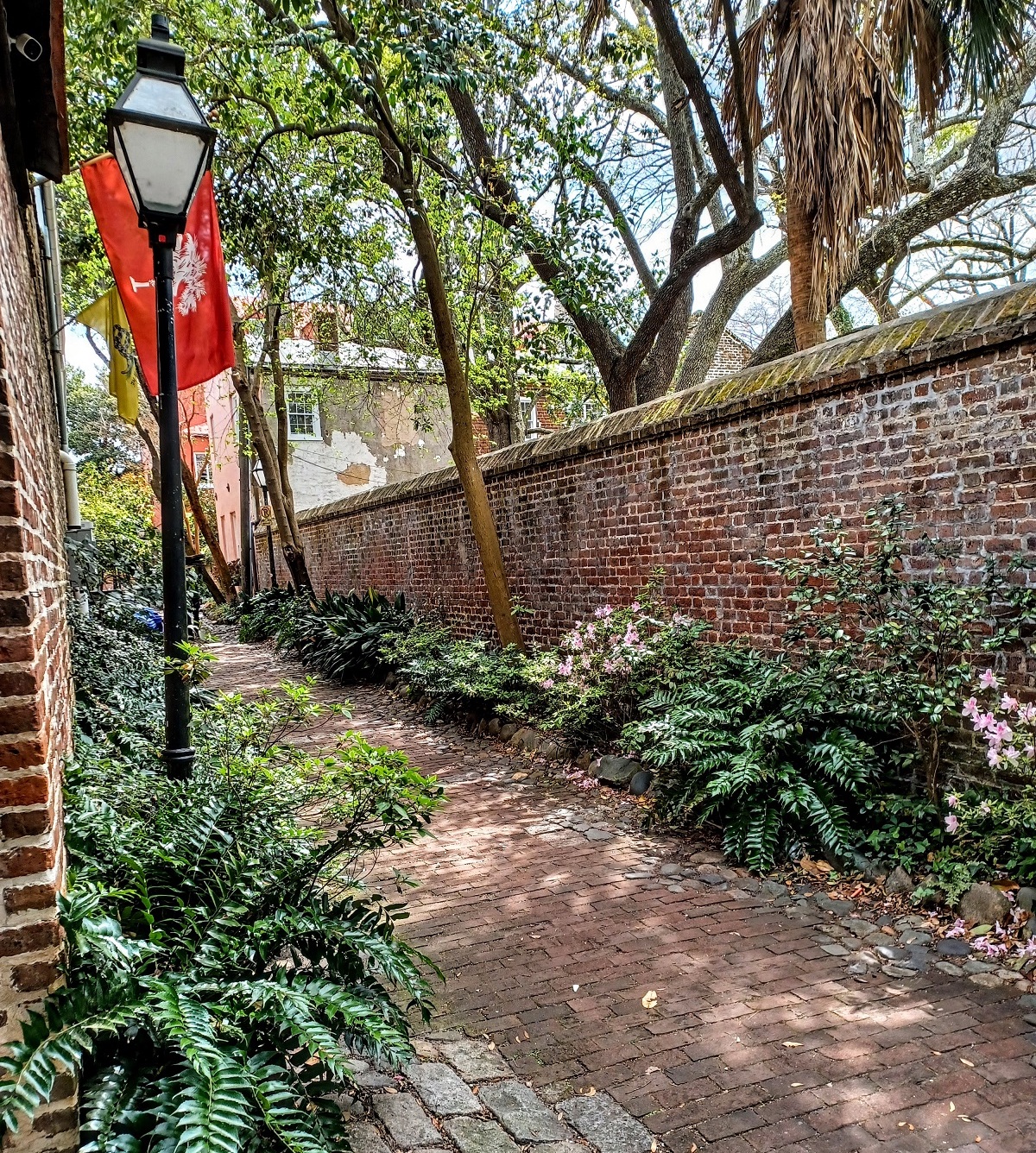
Visting Charleston, South Carolina – The Background
It is less than 200 miles from our door to the Charleston Visitor Center, so we made this a driving vacation. We stopped for lunch enroute but once we arrived at our destination, we parked the car and walked to every stop listed below.
Where we stayed in Charleston
We were eager to stay at the Hilton Club, Liberty Place (475 East Bay Street), which opened in 2021. Note: This is a Hilton Grand Vacation (HGV) “vacation ownership” (aka timeshare) property which can be booked like a hotel through Hilton’s own website as well as numerous OTAs. There is no pool, restaurant, or even bar, although there is a fitness center. HGV has clearly made a significant technology investment in the property’s units; bathrooms feature electric toilet/bidet combinations, a TV integrated into the bathroom mirror, a panel to control window shades, 65” TVs with streaming services, a bedside radio/phone that recharges the TV remote (and recent model cell phones), etc., etc.
The problem is that this technology is “glitchy” – and that’s putting it kindly. We had technicians to our room multiple times who were unable to fix a vexing problem: the complimentary Wi-Fi would kick me off safe websites (including Miles to Memories!) with no discernible pattern, at which point all I could do was a hard reboot and wait until it happened again (which it did – scores of times). This was a major headache since I needed to work from the room. The property knows this is a problem but has neither explanation nor solution, other than to suggest (1) moving to a different room with no assurance things will be any different or (2) work from its 24-hour Business Center.
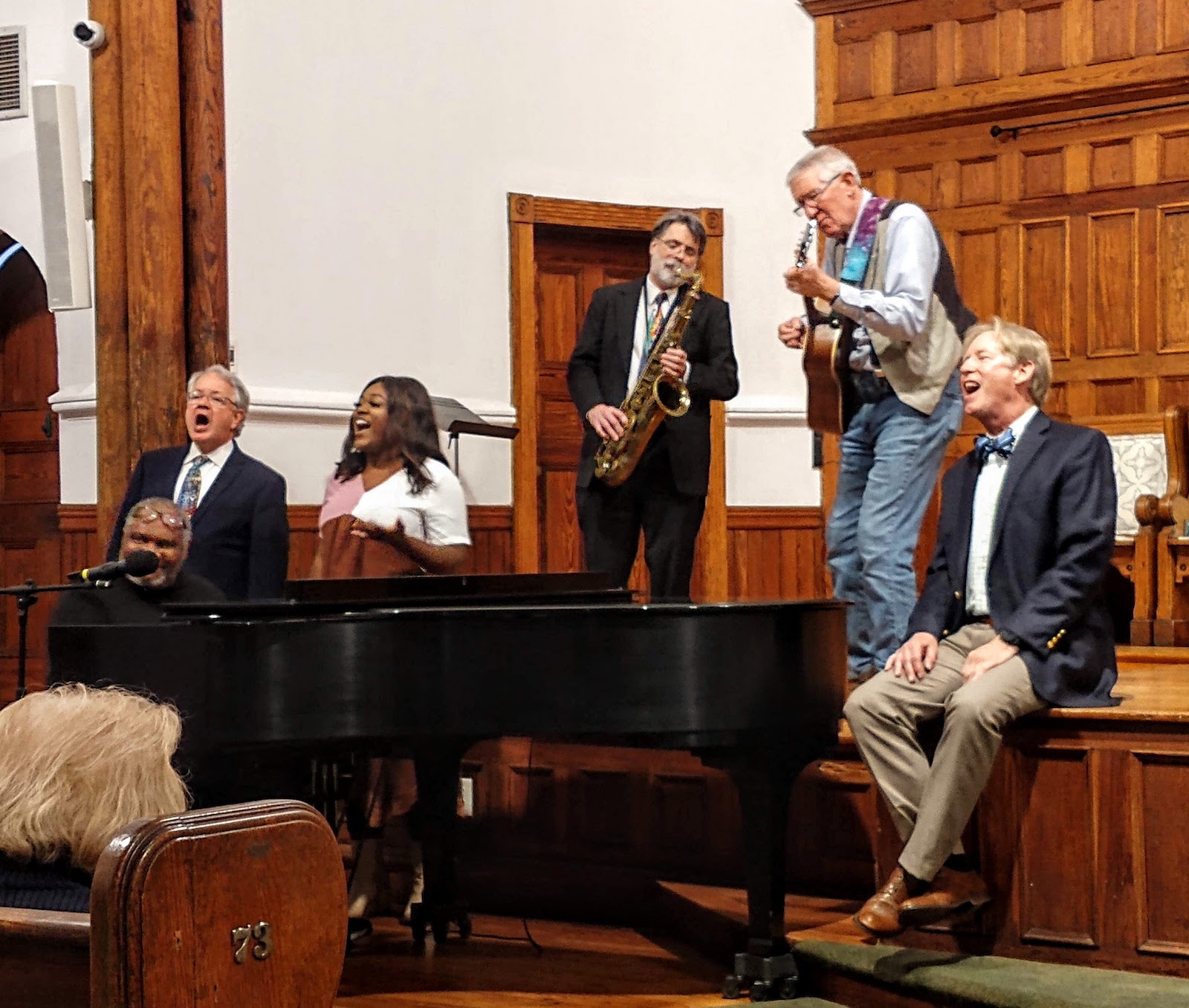
Interesting Facts About Charleston, South Carolina
You may be surprised to learn that Charleston was the wealthiest city in the U.S. during colonial and Antebellum periods. Some other useful factoids include:
- Parking presents a challenge on this peninsula crowded with restaurants, hotels, and retail space, not to mention residents. On-street parking (where permitted for non-residents) is limited to two (2) hours. Valet parking, if offered by your hotel, can be pricey (our hotel wanted $40/day!). There are a handful of free, on-street parking spots along South Battery, but they are gone early in the day and a good distance from most tourist attractions. We found the best solution to be one of the city’s 24-hour garages, which have a daily maximum charge of $18. As a hub for DASH, Charleston’s free downtown shuttle, the garage at the Visitor Center (375 Meeting Street) is a good choice.
- Charleston is a city made for walking. But walking distances can be deceptive as Charleston uses what is called “hundred block” numbering for addresses. So, the walk from 108 King Street to 198 King Street crosses 2 major streets and covers more than ⅓ mile. Gauge the length of your planned route in Google Maps if walking tires you easily. Also, mind your feet as sidewalks can be uneven.
- Mounting blocks (also called “upping stones or “carriage steps”): You won’t walk far before coming across sizeable, rough-cut blocks of stone on sidewalks near the street curb. Some feature a semi-circular section carved out of the side facing the buildings. These were placed there to assist (especially women and children) in stepping up into a horse-drawn carriage.
- Some dates you’ll see referenced repeatedly:
- 1670-1808: Over 40% of all Africans trafficked to North America as slaves arrive through Charleston’s harbor.
- 1861: A fire destroys 600 homes; damages amount to more than $250 million in today’s dollars.
- 1886: One of the largest earthquakes in U.S. history and its 300 aftershocks results in at least 60 deaths and property damage of around $200 million in today’s dollars.
- 1989: Hurricane Hugo, a category 4 storm with 140 mph winds, ripped off the roofs of 80% of the buildings on the peninsula.
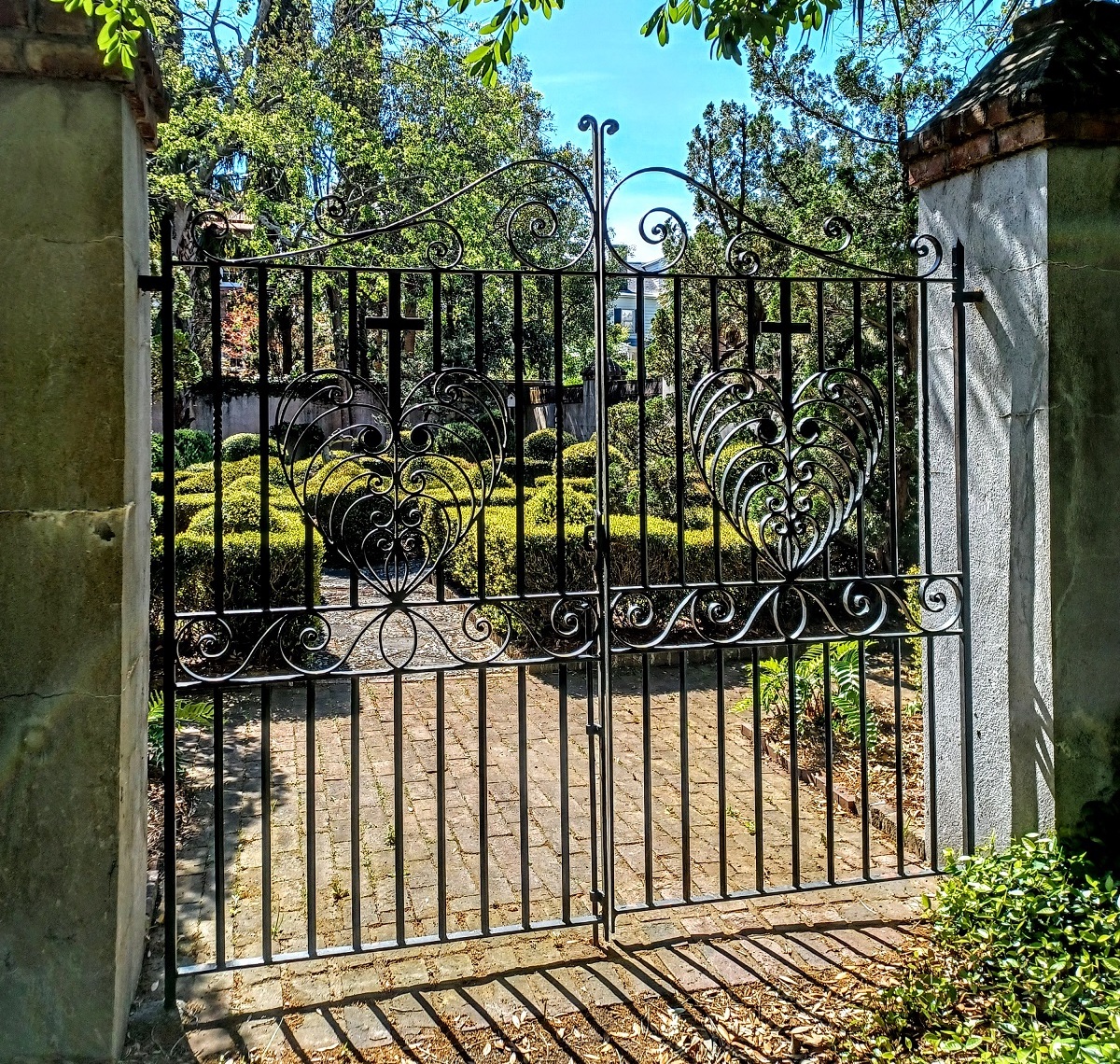
Charleston, South Carolina Self-Guided Walking Tours
Charleston crams more items of interest into a relatively small area than almost any city I know. There are unique things to see every few steps, many of which have a colorful history. The following detailed self-guided walking tours (with maps) are available to M2M readers for the asking:
Secret Alleys & Hidden Passageways
While far from “secret” (you can find dozens of online articles about them) and “hidden” only in the sense that it’s easy to walk by without noticing them, there are numerous short and/or narrow walkways (few are large enough for vehicles!) that are fun to explore:
- Lodge Alley: The building walls on either side of this cobblestone passageway, one of the city’s oldest, frame the spire of St. Philips Episcopal Church for an Instagram-worthy photo.
- Philadelphia Alley: According to legend, this was a popular place for duels. In 2006, the City of Charleston restored and landscaped the lane, now officially “Philadelphia Alley,” resulting in its present shaded beauty.
- Unity Alley: Look for No. 2 At the end of the 18th century, this was Edward McCrady’s Tavern, where President George Washington was lavishly entertained in 1791.
- Bedon’s Alley: Named for merchant George Bedon who (with his wife Elizabeth) held an original land grant and arrived on the first ships to land in Charleston in 1670.
- Longitude Lane: George Bedon had a store at the foot of the alley on East Bay Street, and Nathaniel Russell, one of Charleston’s wealthiest merchants, operated a shop here as well in the late 1700s. Interestingly, Longitude Lane runs east-west instead of north-south.
- Stoll’s Alley: Be on the lookout for the Philip Simmons’ wrought iron gates, some of his earliest commissions, as you stroll along this postcard-perfect lane.
- Zig Zag Alley: One of the shortest streets in Charleston, it includes a 90-degree turn. Also, one of the most often stolen street signs!
- Price’s Alley: On the other side of the wall along the north side of this lane is the 1808 neoclassical home built by wealthy merchant Nathaniel Russell with its cantilevered, 3-story spiral staircase.
- Ropemaker’s Lane: This dead-end alley was the site of Charles Snetter’s rope manufacturing facility in the late 1700s and early 1800s. At 245 feet long and only 10 feet wide, it was long enough to stretch out and intertwine the lengths of hemp used to make ropes for ships of the day.
- St. Michael’s Alley: The house at No. 9 was built in 1913 by DuBose Heyward, whose novel, Porgy, was later made into the opera Porgy and Bess. The beautiful wrought iron “Cross & Egret” gate at No. 2 was designed by renowned Charleston ironworker, the late Philip Simmons.
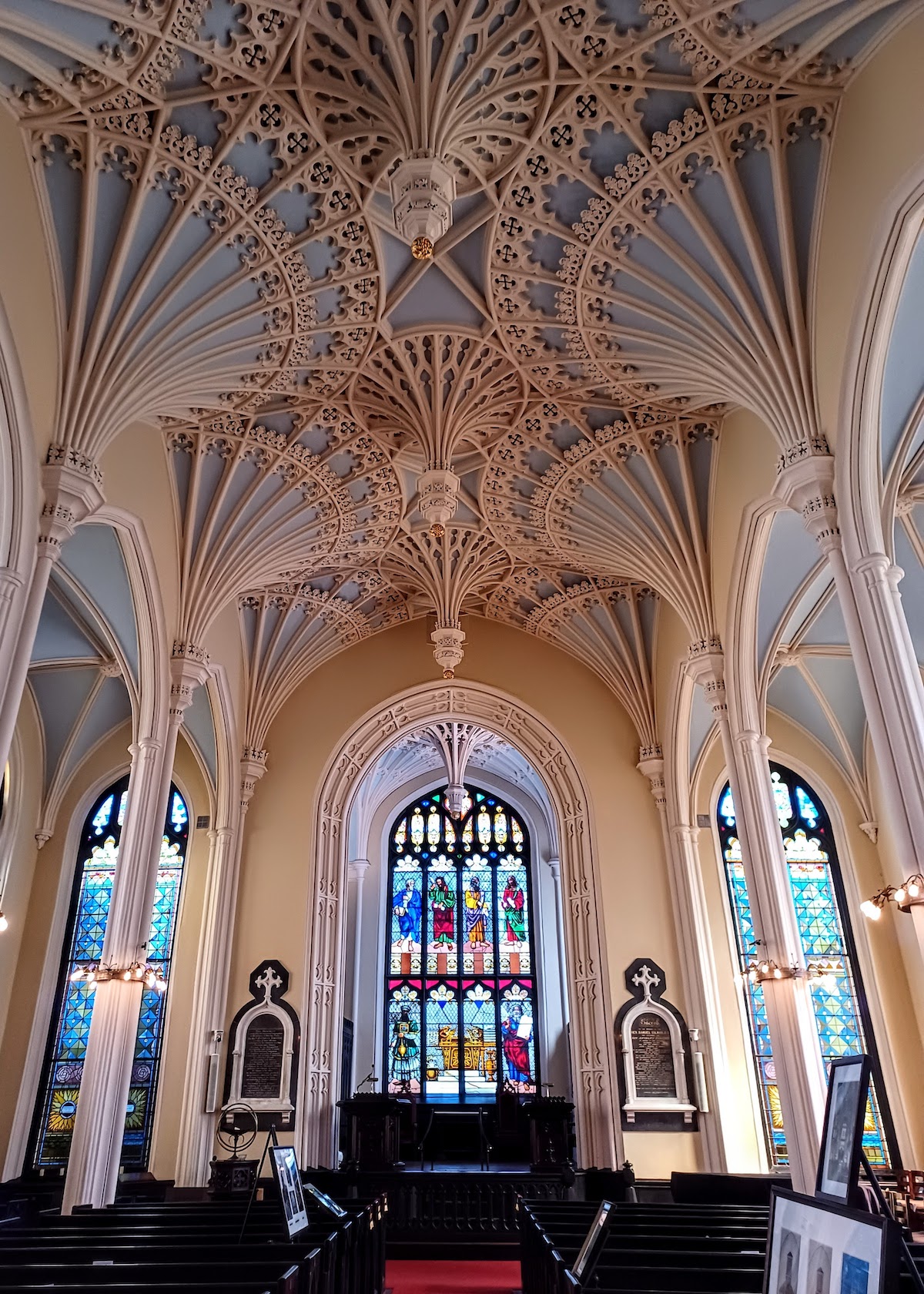
Historic Churches & Their Stories
You’ll often hear Charleston’s carriage drivers and tour guides use the phrase “The Holy City” to describe the city as an historic model of religious freedom when the reality is more nuanced. Carolina (North and South Carolina only became separate colonies in 1712) was founded in 1670 by England which, at the time, had a state religion, The Church of England. Still, houses of worship have always played a central role in the history of Charleston, the Carolina colony, and the U.S. This self-guided walking tour (best done on a Tuesday) includes the following stops:
- St. Matthew’s Lutheran Church: A catastrophic fire in 1965 fire caused extensive damage. The top 18 feet of the steeple remain embedded in the ground next to the sanctuary entrance. Open and hosted by a docent 11am-3pm every weekday.
- Mother Emanuel African Methodist Episcopal Church is the oldest AME church in the southern U.S. and, with a seating capacity of 2,500, one of the largest sanctuaries in Charleston. On June 17, 2015, a 21-year-old self-avowed White supremacist brought a Glock .45-caliber pistol to Wednesday evening Bible study, fired 70 rounds, and killed 9 worshippers, including the church’s senior pastor. Currently not open to visitors.
- St. John’s Reformed Episcopal Church: The exterior of this church tells an all too common and oh so sad story. Maintenance costs on this 160-year-old building pose a challenge for the aging congregation whose members have been forced to move off the peninsula by gentrification. The building is not open to visitors but the garden (see the “Charleston’s Glorious Gardens” self-guided walking tour description) is not to be missed!
- St. Johannes Lutheran Church: The Greek Revival sanctuary building was originally home to St. Matthew’s Lutheran Church (the first stop on this self-guided tour). After St. Matthew’s moved to its present location opposite Marion Park, a small group of German Lutherans who wanted to return to their “home church” and worship in their native tongue acquired the building in 1878. St. Johannes purchased the 2½-story single house on Hasell Street next to the sanctuary for its parsonage in 1919. The church’s last pastor to reside here moved on in 2006 and the church faced a difficult decision: sell “as is” or take on an extensive – and expensive – restoration project. After years of dispute and debate, the small congregation took out a 25-year, $350,000 loan to reimagine the former parsonage as an event venue (primarily wedding) complete with English garden, reception hall, and, if desired, sanctuary. Check the church’s “Events” calendar for opportunities to visit.
- St. Philip’s Episcopal Church is often referred to as the “Westminster Abbey of South Carolina,” for its London-influenced Anglo-Palladian style. Among those buried in its graveyard (across the street) are Edward Rutledge (a signer of the Declaration of Independence), Charles Pinckney (a signer of the Constitution), John Calhoun (U.S. Senator and Vice-President), and DuBose Heyward (author of the novel Porgy, upon which Gershwin’s American opera, Porgy and Bess, is based).
- French Huguenot Church: “Huguenot” is the name given to French Protestants who were harshly persecuted by the French Catholic Court during the Reformation. This is the home of the only present-day independent Huguenot Church in America and South Carolina’s oldest Greek Revival-style church. Open Monday-Thursday from 10am-4pm and Fridays from 10am-1pm in the spring and fall months.
- St. Michael’s Episcopal Church is Charleston’s oldest church building and one of the Four Corners of Law. The church’s website indicates the sanctuary and grounds are open Monday, Tuesday, and Thursday from 9am-4pm.
- Cathedral of St. John the Baptist: Above the high altar in this structure of Connecticut tool-chiseled brownstone is a five-light window copied from Leonardo DaVinci’s Last Supper. The rose window over the entrance depicts the Jesus’ baptism by his cousin, John the Baptist. Weekday mass is at 12:05pm.
- Unitarian Church: The perpendicular Gothic style and delicate fan tracery ceiling was patterned after King’s College Chapel in Cambridge, England. The early art nouveau side windows were added after a hurricane in 1885. In keeping with the Unitarian tenet that death is part of the natural order, plants grow wherever they like in the adjoining garden cemetery, which pays homage to the free-flowing plan of Mt. Auburn Cemetery in Cambridge, MA, also established by Unitarians. Just inside the Archdale Street entrance to the churchyard is a memorial constructed using bricks from the original church building and dedicated to “…the enslaved workers who made these bricks and helped build our church.” Each year, “…houses of worship across the peninsula welcome …visitors…interested in learning more about the history, culture and faith of the congregations lining (Charleston’s) streets” at an event called “Spirited Brunch” (April 23 in 2023). The Unitarian Church will be serving Thomas Jefferson’s deviled eggs and Abigail Adams’ apple pan dowdy (Abigail Adams was Unitarian and Jefferson held Unitarian beliefs).
- St. Mary of the Annunciation was the first Catholic church established in Georgia and the Carolinas. Its 33 stained-glass windows were created by the famed Mayer Glassworks in Munich. The 4 angels in the chancel area are copies of angels found in Fra Angelico’s Madonna of the Linen Weavers hanging today in the Museum of Saint Mark in Florence, Italy. According to its website, the church and grounds are open daily from 8am until late afternoon or early evening; observe the schedule for Mass.
- The Greek Revival style Kahal Kadosh Beth Elohim is the second oldest synagogue building in the country and the oldest in continuous use. Its small museum, which has a letter George Washington wrote to the congregation and an original painting of the interior of the 1792 synagogue among its artifacts, is open from 10am-3pm (closed Wednesdays and Saturdays). Docent-led tours, which include a documentary video and museum admission, are offered on the same days ($12/adult, $5/ages 5-7, free for active military and college students).
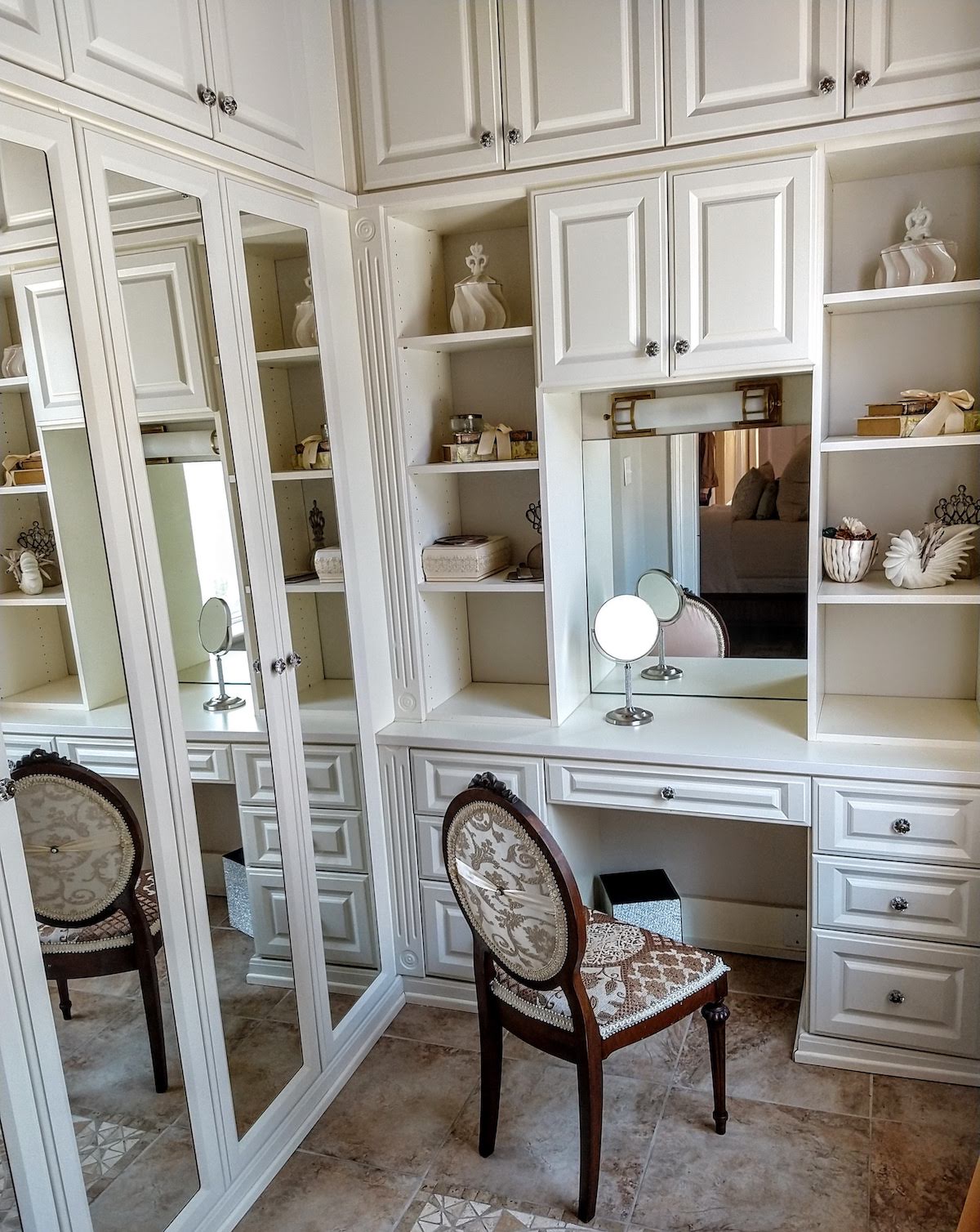
Charleston’s Glorious Gardens
Charleston has been described as “a city nestled in a garden.” This self-guided tour highlights some of the better-known gardens which are clustered on the Battery end of the peninsula. But keep your eyes open as you walk and make your own discoveries!
- The Garden Club of Charleston maintains the large garden of the Joseph Manigault House which features landscaped shrubs and flowerbeds, workers’ quarters, a stable and kitchen.
- The Philip Simmons Memorial Garden (aka the “Heart Garden”) behind St. John’s Reformed Episcopal Church celebrates two of South Carolina’s internationally known artisans: topiary artist Pearl Fryar and “the poet of ironwork,” blacksmith Philip Simmons who worshipped here until his death in 2009. In 1982, the National Endowment for the Arts awarded Simmons its National Heritage Fellowship, the highest honor that the United States can bestow on a traditional artist. Note the Single Heart Gate to the walkway from Anson Street, the Double Heart Gate to the entrance of the topiary garden, the gate on the back wall and the recurring heart theme throughout the garden.
- Nathanael Russell House: You used to be able explore the period gardens here for free; access is now restricted to those who pay to tour the house with its three-story, cantilevered, flying staircase.
- Dr. Vincent Le Seigneur House: Crushed limestone pathways divide this long, narrow garden into several “rooms” relating to the different facades of the house and pool, incorporating boxwoods, olive trees, giant taros, and climbing roses.
- The Williams Mansion is the largest single-family residence in South Carolina at 24,000 square feet. The widely spaced bars of the gate invite those who stroll by to admire its Italianate façade and manicured garden. Scenes from The Notebook were filmed here.
- The garden of the John Blake House was restored in 1985 to a formal parterre design based on documented 18th and 19th century Charleston gardens. Gardens in this style were meant to be enjoyed looking down on their design.
- The Shamrock Garden at the Simmons-Edwards House is a neatly manicured garden surrounded by historic buildings. This is a private garden, but it is easy to snap a photo through the black, iron fence.
- The beautiful garden of the William Gatewood House, framed by gorgeous old oak trees and planted with an array of classic Southern plants was designed for the house by landscape designer Deborah Nevins.
- Named for the 10 beautiful wrought iron gates found along its meandering path, Gateway Walk begins at the corner of Clifford and Archdale Streets in the churchyard of St. John’s Lutheran Church and winds across 3 city blocks in the heart of Charleston’s French Quarter. Sit for a minute at the small tables around the edges of the formal Lenhardt Garden of the Gibbes Museum of Art to admire its peaceful fountain and perfect symmetry.
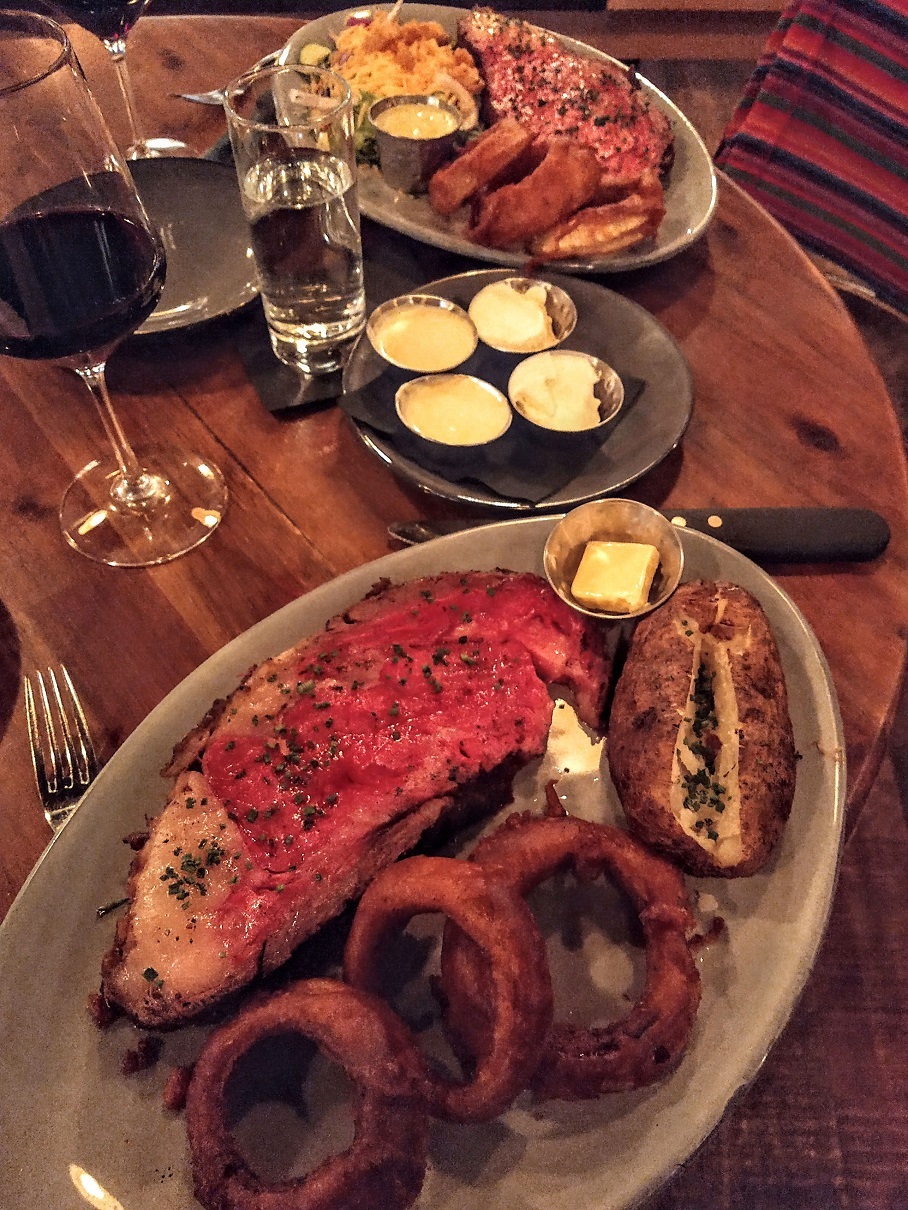
Eating in Charleston, South Carolina
Stones Throw Tavern has 2 locations in Charleston; we stopped at the Northwoods Mall location on the way to our hotel. It was here that we first encountered a surcharge for using a credit card to pay for our meals. There is nothing on their website and I don’t recall seeing anything on their printed menu nor any signage at the reception station warning diners of this practice but when we received our bill, two prices were listed – the cash price which reflects the prices on the menu and a credit price which was 3.3% higher!
Toast has 6 locations in Charleston, 2 downtown. Tip: While there was an hour wait for a table at 10am at the Meeting Street location, we were seated immediately at the King Street location. Some unusual (and decadent) offerings include a blue crab and shrimp omelet ($23), deluxe French toast (bakery-made cinnamon-swirled currant bread, stuffed with apples or peaches, then dipped in French toast batter and deep fried, $13 single/$18 double), and a Philly steak biscuit (shaved ribeye, peppers, onions, and melted pepperjack cheese on top of a humongous biscuit with two eggs – any style for $16).
Another Broken Egg Café is a national chain with 80 locations, one on Market Street near the beginning of the City Market complex. Notable menu choices here include a lobster and brie omelet, lemon-blueberry goat cheese pancakes, and (my choice) cinnamon roll French toast.
Mercantile and Mash are separate entities owned by the same company operating out of Charleston’s historic cigar factory building (701 East Bay Street) where striking workers first sang “We Shall Overcome”. Mercantile serves an all-day breakfast along with soups and salads and an extensive list of hot and cold beverages (coffee, tea, and smoothies) starting @ 7am weekdays, 8am on weekends. From 10am until close (mid to late afternoon) every day they also serve sandwiches, bowls, charcuterie, etc. Bar Mash opens daily at 4pm for Happy Hour featuring a daily whiskey selection ($3), Miller High Life draft ($2.50), glasses of wine ($6), chips and house made queso ($5), $7 burgers, and $4 soft pretzels. But the fun really starts with its evening events: Wednesday is Burger night (get a Mash Burger, fries and Miller High Life for $12); Thursday night from 7-9pm is team trivia night (free to play, chance to score a gift card for a future dine); Monday’s Prime Rib and Live Music special features huge slices of prime rib, onion rings, and a baked potato or salad (shown here) for $29. A live band plays from 9pm-midnight.
At least Fleet Landing Restaurant & Bar’s home page includes the fairly prominent disclosure statement, “We impose a credit card fee of 3% on transactions when paying with a credit card….” Unfortunately, we had made our reservation through OpenTable and their listing there does not include any such disclosure. We ended up each having a bowl of she crab soup ($10), then sharing starters of lump crab bruschetta ($15) and chilled blue crab dip ($12), and finishing with white chocolate bread pudding and Fleet Landing chocolate torte (each $9).
Fast & French: This small café and art gallery focuses on fresh soups and daily specials, serving 3 meals/day Monday through Saturday and brunch on Sunday. We both ordered the bouillabaisse, a traditional Provencal fish stew consisting of shrimp, scallops, mussels, flaky white fish, zucchini and sweet pepper in a white wine and saffron broth. This was served with soup or salad, assorted breads (to sop up all that good broth!), and a glass of French wine (white, red, or rose) for just $28. Best of all, the bouillabaisse is prepared tableside (pictured here); it doesn’t get any fresher than that! The desserts looked yummy, too.
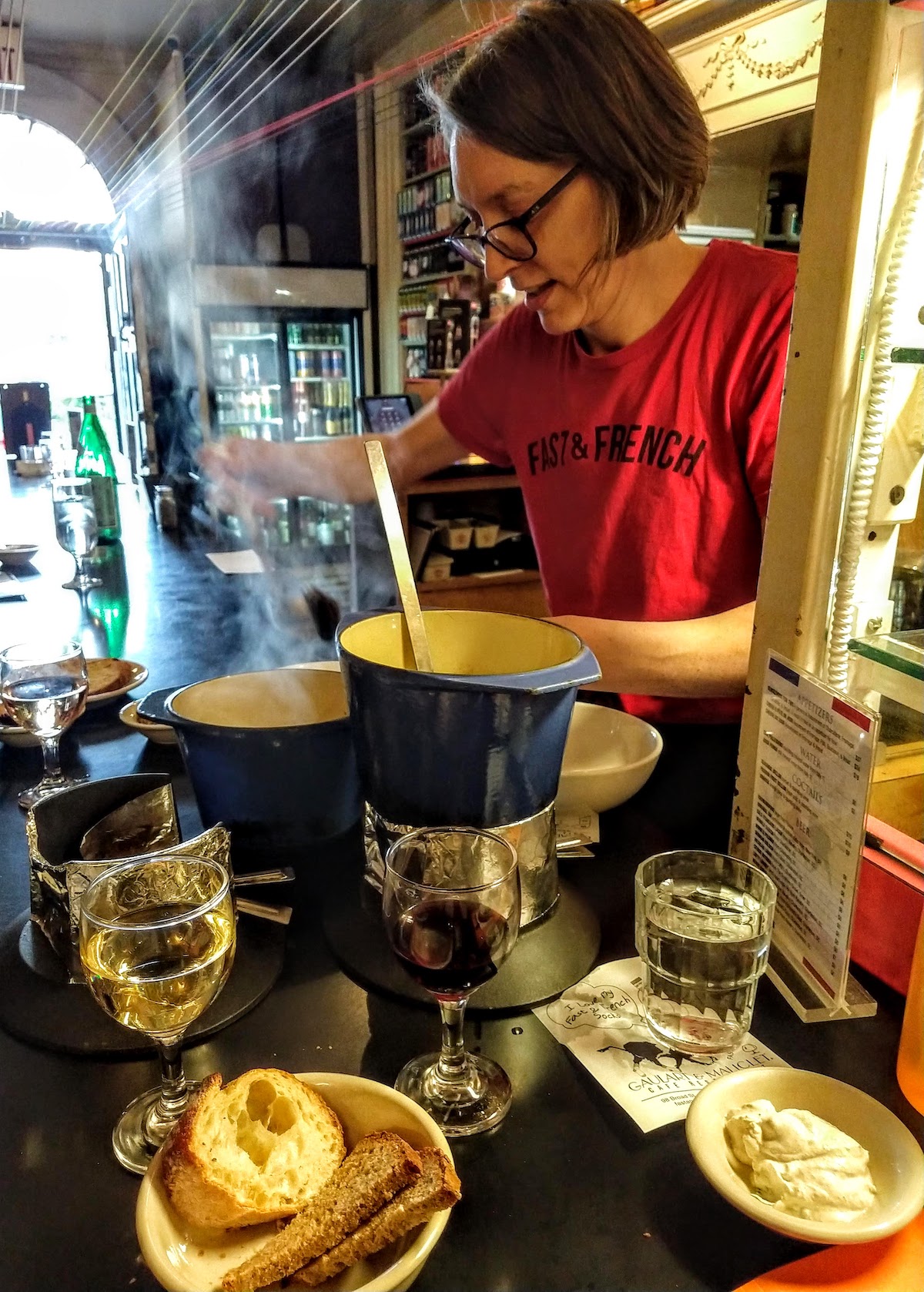
Other Things to Do in Charleston, South Carolina
The Gibbes Museum of Art has a permanent collection of over 7,000 items. To its credit, it acknowledges its legacy of having been built with a bequest from a slaveholder and is committed to “…intentionally fostering an inclusive, accessible museum fashioned upon a foundation of equity.” Admission is $12/adult, $10/senior, military, college student and $6/ages 4-17; free for NARM/ROAM members.
The $26/person we paid for The Sound of Charleston tickets was probably the best money we spent on this trip. Charleston’s longest running musical production is part history lesson, part concert, and a whole lot of inspiration crammed into 75 minutes (our show actually ran for 90 minutes). It’s like Prairie Home Companion without Lake Wobegon. Music, interspersed with entertaining and educational narration from a skilled storyteller is used to trace Charleston’s 350-year history. The venue for The Sound of Charleston is Circular Congregational Church where John Newton worshipped in the spring of 1749, a year after his conversion to Christianity which he attributed to surviving a violent storm aboard his slave trading ship in the North Atlantic. Every performance of The Sound of Charleston ends with audience and musicians joining to sing Amazing Grace, which Newton began writing in 1772 and published in 1779.
The Black Fedora Comedy Mystery Theater puts on audience-interactive comic mysteries most evenings for $27/adult, $25/12 and under. A small cast of professional actors is complemented by audience members who choose to play a character using provided scripts. Reasonably priced drinks, munchies and desserts are available for purchase before the play begins and during intermission.
Visting Charleston, South Carolina – Bottom Line
I hope this gives you some new ideas for how to have a jam-packed, affordable vacation in Charleston, which you can drive to in a day from almost anywhere in the southeastern U.S. Happy traveling!



[…] Source link […]
Oh, if you liked Charleston, you have to make it down to Savannah. Savannah is the best walking town anywhere on this plant and the most unique city. I use to work there and now live between Charleston and Savannah in Beaufort. Beaufort regularly makes the top 10 list for coastal towns.